Applied Wireless Identifications Group LR911 Long Range Proximity Reader User Manual
Applied Wireless Identifications Group Inc. Long Range Proximity Reader
User Manual
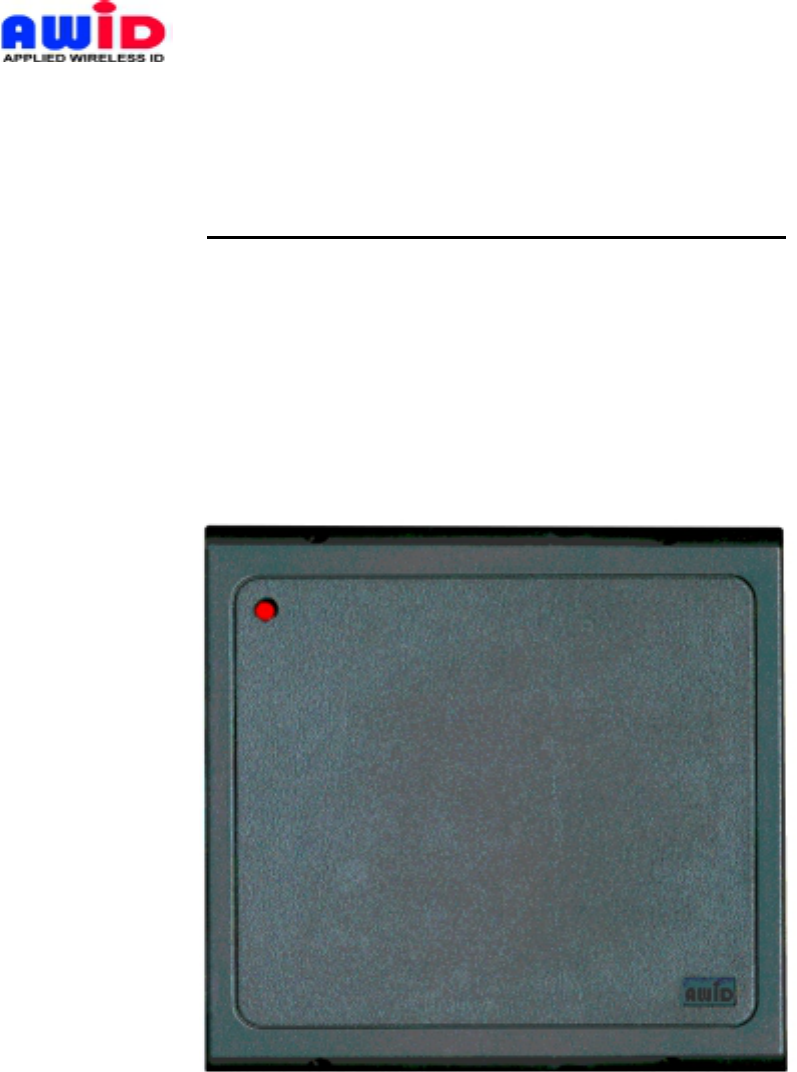
1
AWID PROPRIETARY
Applied Wireless Identifications Group, Inc.
SENTINEL-PROX LR-911
LONG-RANGE TAG READER
Installation & Operation Manual - 006-99-A
Your Best Option for Long Range UHF Readers
Last Update: July 18, 2001

2
AWID PROPRIETARY
Table of Contents
1.0 Introduction………………………………………………………………………Page 3
1.1 General Description..………………………………………………………….. 3
1.2 Special Features…………………………………………………………….… 3
1.3 Suggested Applications………………..………………………….…………. 3
2.0 Principal of Operation………………………………………………………………… 3
3.0 Specifications…………………………………………………………………………. 4
3.1 Measuring Read Distance…..……………..……….……………….………. 4
4.0 Preparation for Installation………….…………………………...…………………... 4
4.1 Site Survey……………………………………………………………………. 4
4.2 Preferred Reader Installation Practice……………………………………… 5
4.3 Metal Mounting…………………………….…………………………………. 5
4.4 General Wiring Requirements…………………..……...…………………... 5
4.5 Power Supply…………………………………………….…………………… 6
4.6 Power Supply Current Draw and Wiring Gauge …………………………. 6
4.7 Grounding…………………………………………………………………….. 7
4.8 Wiring Diagrams……………………………………………………………... 8
5.0 Installation Procedure……………………….……………………….……………... 8
5.1 Parts List……………………………………………………………………… 8
5.2 Installation Steps………………………………..…………………………… 8
5.3 Verification…………………………………………….……………………… 8
5.4 Mounting……………………………………………………………………... 11
5.5 FCC RF Exposure compliance…………………………………………….. 11
6.0 Warranty…………………….……………………………………………….……….. 11
7.0 Return Material Authorization (RMA)……………………………………...…..…. 11
8.0 Troubleshooting……….………………………………………………….……….…... 11
9.0 Patents and Approvals…………………………………………………….……….... 12
NOTE: READ AND USE THIS MANUAL.
FAILURE TO DO SO MAY RESULT IN POOR READER PERFORMANCE OR EVEN
PERMANENT DAMAGE TO READER, WHICH COULD VOID THE READER
WARRANTY.
List of Tables
Table 4.4-1: Data Line’s Wiring Distance Requirement…………………………….Page 5
List of Figures
Figure 4.6-1: Fig. 4.6-1 Read Range VS. Wire Gauge and Supply Voltage (300 ft) Page 6
Figure 4.6-2: Fig. 4.6-1 Read Range VS. Wire Gauge and Supply Voltage (500 ft) ……. 7
Figure 5.2-1: Wiring Diagram for Wiegand Output Format……….…………….…………… 9
Figure 5.2-2: Wiring Diagram for RS232 Output Format…………………………………….10
Figure 5.2-3: Wiring Diagram for RS232 & Wiegand Output Format…….…………………1

3
AWID PROPRIETARY
1.0 INTRODUCTION:
AWID's Sentinel-Prox LR-911 Reader is a long-range (9 to 11 feet) reader that works with
paper-thin passive windshield mounting tags or credit card size tags. This reader comes with a
unique combination of long read range, small size and low power consumption. LR-911 has an
internal power DC/DC converter, allowing it to work with wide range of supply inputs without
affecting its performance. With a 16 V DC supply, its current consumption is less than 400 mA,
making it possible to be powered directly from the supply in the access control panel, thereby
eliminating the need for an external supply. LR-911 has simultaneous Wiegand and RS-232
outputs, its primary applications are automated parking garage entrance control, hands-free
access control, asset tracking and asset management applications.
1.1 General Descriptions:
• Wall mount or post mount reader
• Indoor or outdoor installation
1.2 Special Features:
• Thin passive tags with long range performance
• Designed for automated operation with tags mounted on automobile’s windshield
• Simultaneous Wiegand (Access Control) and RS-232 (transaction control) outputs
• Permanently sealed electronics for indoor or outdoor applications
• UV stabilized plastic housing
1.3 Suggested Applications
• Garage Gate Control
• Asset Management
• Item Tracking
• RFID
2.0 PRINCIPAL OF OPERATION
This Radio Frequency Identification (RFID) reader uses radio frequency to identify, locate and
track people and objects that carry the appropriate transponders. RFID readers can work in
none line-of-sight situations and in darkness, bright sun light or through dirt, grime and
smudges.
A typical RFID system consists of three components – an interrogator or reader, a transponder
or card and a data processing panel and/or computer combination. Most RFID readers have an
internal micro-controller, transmitter, receiver and a shared transmit/receive antenna. The card
is usually passive (no internal battery) and consists of an antenna and RFID ASIC (Application
Specific Integrated Circuit). During operation, the transmitter sends out an electromagnetic
wave to establish a zone of surveillance. When a transponder enters this zone, the
electromagnetic energy from the reader begins to energize the IC in the

4
AWID PROPRIETARY
transponder. Once the IC is energized, it goes through an initialization process and is ready to
accept further commands. Upon receiving a command to broadcast its identity, the RFID ASIC
begins to broadcast its identity through a low energy back-scattering technology that selectively
reflects or backscatters the electromagnetic energy back to the reader. The receiving circuits in
the reader senses and decodes this back-scattered signal and hence determines the identity of
the transponder.
3.0 SPECIFICATIONS
- Input voltage……………………………. +6V to + 16V DC
- Input current……………………………... 1.2 to 0.40 A typical
- Read range:
Nominal (Line of Sight) 10 feet
Transmit frequency……………………… 902-928 MHz
- Receiver frequency……………………… 902-928 MHz (Amplitude Modulated)
- Operating temperature range…………...-30° C to +55° C
- Color………………………………………. Dark Gray and Beige
- Output formats available……………….. Simultaneous Wiegand & RS-232 (Standard)
(Others are available upon request)
3.1 Measuring Read Distance
The transponder for this Reader is designed for windshield mounting. To measure the read
range between the Reader and the transponder, the transponder must be placed behind a piece
of glass of about 0.25 inches in thickness and the transponder must be flat against the glass.
Grasp the transponder by the edges and hold the transponder in the same orientation as
indicated in the transponder. Move the transponder toward the Reader, with the card surface
parallel to the Reader, until confirmed data detection occurs. This indicates that the Reader has
successfully read the transponder. In order to read again, the card must be fully withdrawn from
the Reader’s field of view and then approached again.
NOTE: FAILURE TO FOLLOW THE INSTALLATION GUIDE MAY RESULT IN POOR
PERFORMANCE OR EVEN CAUSE PERMANENT DAMAGE TO THE READER,
THUS VOIDS THE PRODUCT WARRANTY.
4.0 PREPARATION FOR INSTALLATION
4.1 Site Survey:
Always conduct a site survey before starting installation, avoid any possible sources of
interference. If the Reader is not installed properly, the performance will be degraded or more
seriously the Reader may be damaged. The following is a list of installation procedures that
should be followed during installation:
AWID PROPRIETARY

5
• Do not install the Reader in an area where sources of broadband electromagnetic noise
may exist. Avoid mounting the reader facing a cellular phone tower or in close proximity
to the base station of a 900 MHz wireless telephone.
• Keep all the Reader wiring at least 12 inches (30 cm) away from all other wiring, which
includes but is not limited to, AC power, computer data wiring, telephone wiring and
wiring to electrical locking devices.
• Do not operate the reader in close proximity to any 900 MHz wireless equipments.
4.2 Preferred Reader Installation Practices
• Avoid mounting reader under direct sun light. Sun light in some locations may cause the
reader to be operating at temperatures well above the 55 degrees Celsius limit.
• Make sure that the supply voltage of the Reader is within specification.
• Use cables with over-all braid or shield.
• For best results, run the cable in an individual conduit, at least 12 inches from AC power,
computer data cables and cables for electrical locking devices.
• Use recommended cable. Do not use any un-shielded "Twisted Pair" type cable.
• Use the largest wire gauge possible (22AWG and thicker).
• Use a dedicated power supply, where necessary.
• Use Single Point Grounding (Earthing) for black wire of cable. No ground loops. Outer
shield of cable should not be grounded.
4.3 Mounting Preference
The LR-911 has a unidirectional antenna with an antenna beam width of about 60-70 degrees.
The radiation pattern is a cone shaped beam, which should be aimed to the location where the
transponders will pass. For best results, the antenna should be mounted on a post; about 6 to 7
feet from pavement with the antenna angled slightly downward.
With a vehicle passing through the drive lane, the center of the antenna radiation pattern should
project to the windshield directly in front of the passenger side.
Be sure to elevate the antenna slightly to accommodate sport utility vehicles and minivans. Fig.
4.3-1 is a typical mounting arrangement that should work in most single lane and multi-lane
cases.
4.4 General Wiring Requirements
All the Reader wiring must be continuously shielded. AWID recommends using #22 AWG up to
#18 AWG, six or seven-conductor shielded cables. Longer distances and higher current
consumption on the power supply line may require larger gauge wires. Due to system data
termination differences, contact your panel manufacturer for the proper wire sizes to meet their
specific requirements.
AWID PROPRIETARY
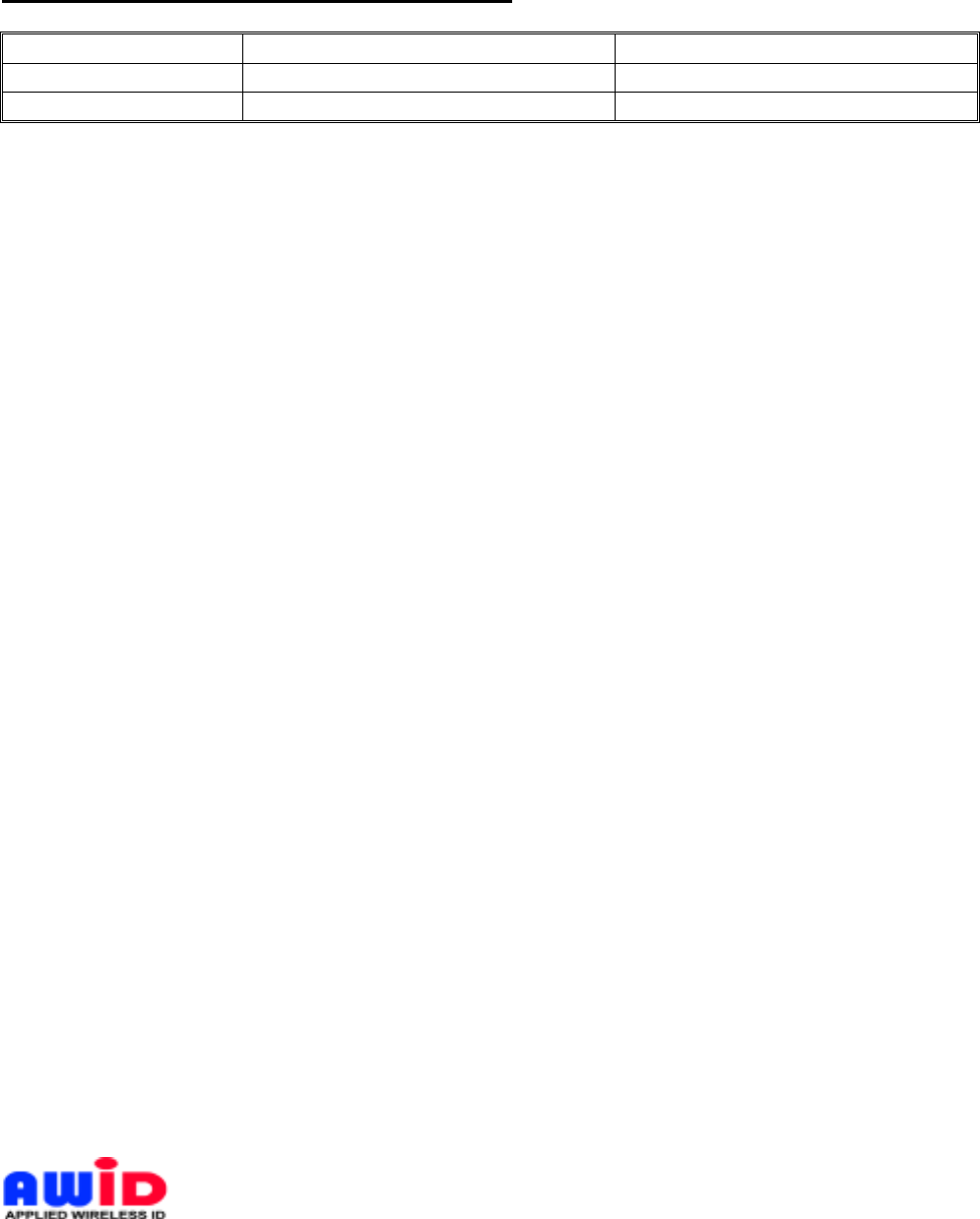
6
TABLE 4.4-1: Data Line’s Wiring Requirement
WIRE SIZE #22 AWG (0.6mm Dia.) #18 AWG (1.2mm Dia.)
WIEGAND 500 ft (152 meters) 980 ft (300 meters)
RS-232 45 ft (15 meters) 45 ft (15 meters)
4.5 Power Supply
For consistent performance, choose a Low Noise/High Efficiency switching power supply
4.7 Grounding
Grounding is critical for proper operation of the Reader. When installing the Reader, it is crucial
to assure that the earth ground is the best ground available. If you elect to use the AC main
power ground, conduct a test by measuring its resistance relative to a known good ground, such
as a cold water pipe or a structural steel that is in direct contact with the ground. The resistance
should be less than 50 ohms. If you find that the AC main power does not provide adequate
earth ground, try using a solid connection to a cold water pipe.
Outer shield of cable should not be grounded.
For multiple Reader installations, it is critical that all Readers are connected to the same
grounding system. Using different grounding systems will create secondary current paths or
ground loops that can affect the performance and cause damage to the Reader.
4.8 Wiring Diagrams
See Fig’s 5.2-1,2,3
5.0 INSTALLATION PROCEDURE
Verify that all item listed in Section 5.1 of this manual are present before starting the installation.
5.1 Parts List
A. Installation sheet, P/N: 006-99-A QTY=1
B. Sentinel-Prox LR-911 Reader, P/N: 004-20-A QTY=1
C. #6-32 x 1” Machine screw, P/N: 0616MPP QTY=4
D. #6-32 Hex Machine Screw Nuts, P/N: 06NH QTY=5 (1 spare)
E. #6 External Tooth Lockwashers, P/N: 06WE QTY=5 (1 spare)
F. Screw hole plug, P/N: 004-27-A QTY=5 (1 spare)
AWID PROPRIETARY
5.2 Installation Steps

7
Installation Procedure
1.) Position the Reader (Item b on Parts List) at the desired mounting position on a
mounting post or a mounting surface. Use Figure. 1 as guide. For straight mounting,
drill four small holes for mounting screws, and one clearance hole for reader cable.
The installer determines the size of the mounting holes and the clearance hole.
2.) For straight mounting, insert both cable slot plugs (item g on Parts List) to bottom
cover.
3.) For side mounting, bend and press the cable into the curved channel and guide the
cable out on the desired side of the LR-911. Insert one cable slot plug to the other
side of the bottom cover with no cable coming out.
4.) For Wiegand output, connect the Reader and the Panel together according to Figure
2. Install reader onto the mounting surface with items c, d, and e on Parts List. (For
other data format, see Note 3.)
5.) Read Note 1 and below then insert item f. on Parts List into the four screw clearance
holes to conceal the screws.
5.3 Verification
a. Power up the PANEL, Connect a PC, which has the special test program installed, at the
RS-232 output port.
b. Place a “good” card in front of the Reader and keep it in that position. The reader
program will confirm that the data has been detected.
c. The reader uses an internal micro-controller to manage its many functions, and the
micro-controller must be initialized properly. When the reader show evidence of
malfunctioning, turn off the reader and wait for ten seconds before energize the reader
again.
AWID PROPRIETARY
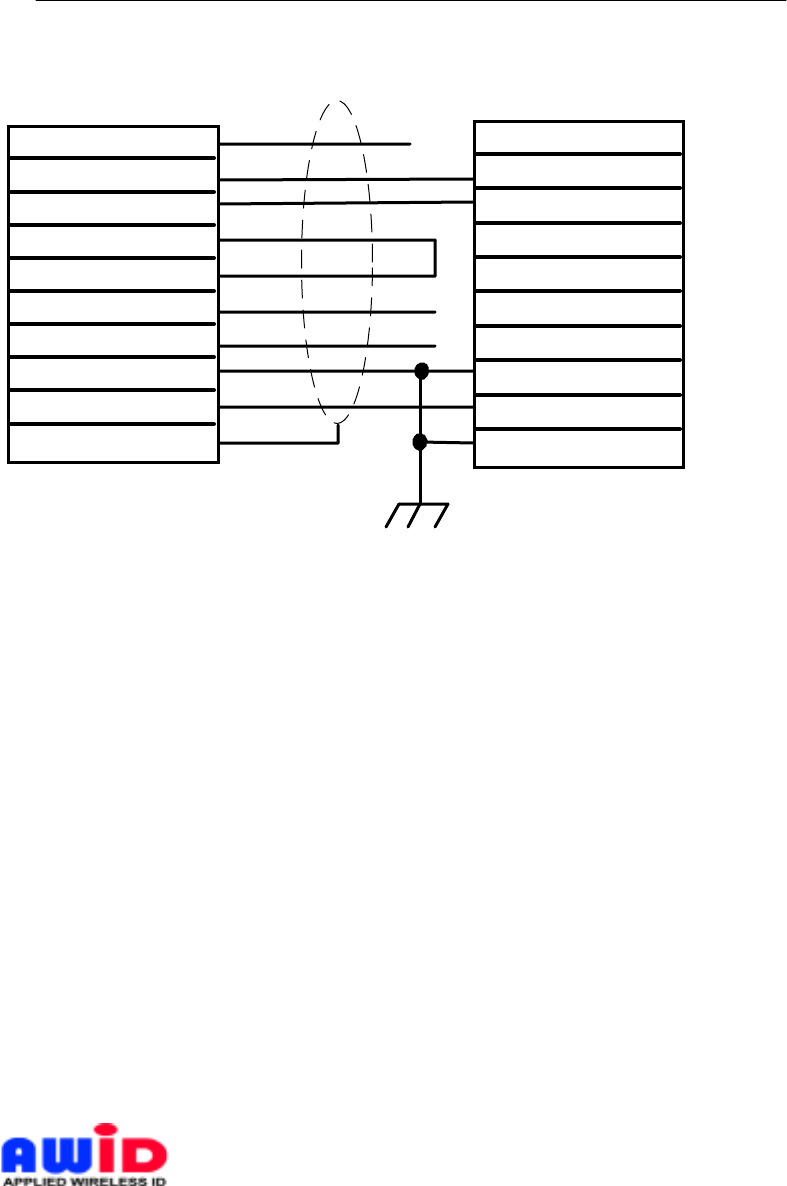
8
AWID PROPRIETARY
Ext Data (Yellow)
Data1 (White)
Data0 (Green)
RS Ground (Blue)
Reset (Brown)
Transmit (Violet)
Receive (Orange)
Ground (Black)
6-16 VDC (Red)
Shield Drain)
Data1
Datao
Ground
Power
Chassis Ground
Fig 5.2.1 Wiring Diagram For Wiegand Output Format
READER PANEL
Earth
Ground
Braid
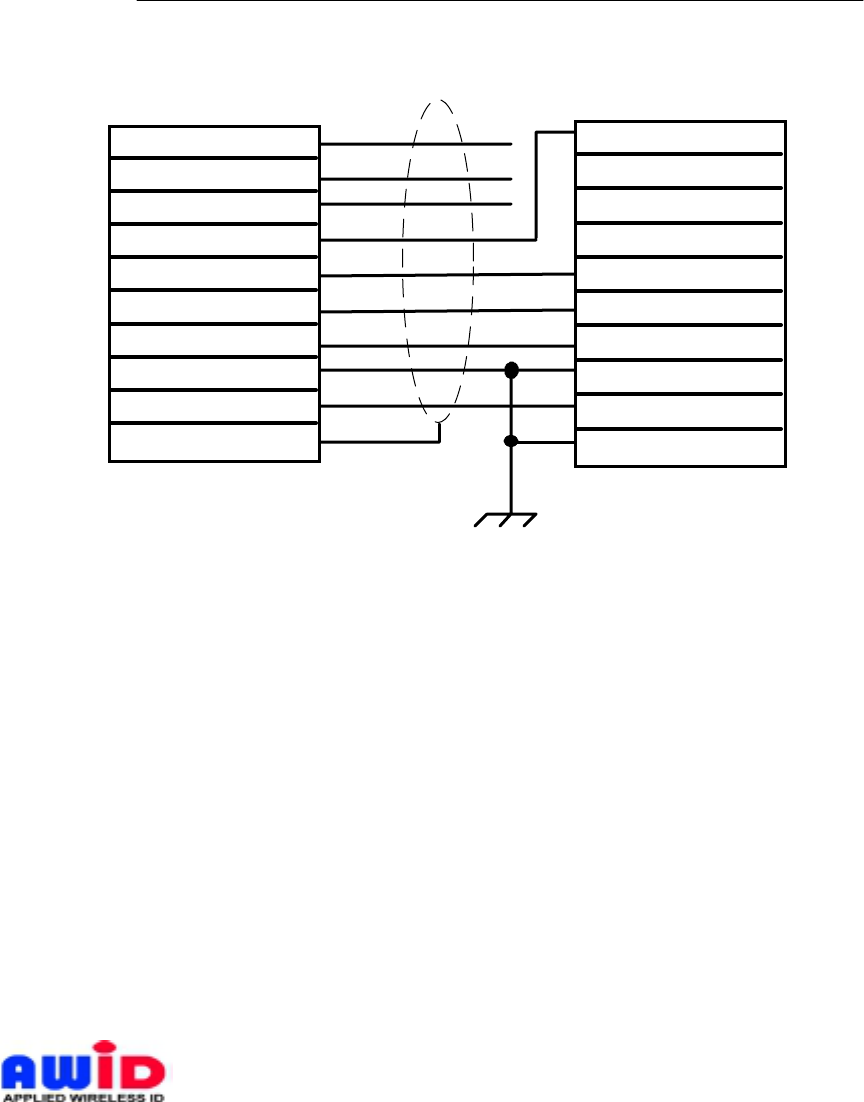
9
AWID PROPRIETARY
Ext Data (Yellow)
Data1 (White)
Data0 (Green)
RS Ground (Blue)
Reset (Brown)
Transmit (Violet)
Receive (Orange)
Ground (Black)
6-16 VDC (Red)
Shield Drain)
RS Ground
DSR
DTR
CTS
RTS
RXD
TXD
Ground
Power
Chassis Ground
Fig 5.2.2 Wiring Diagram For RS-232 Output Format
READER PANEL
Earth
Ground
Braid
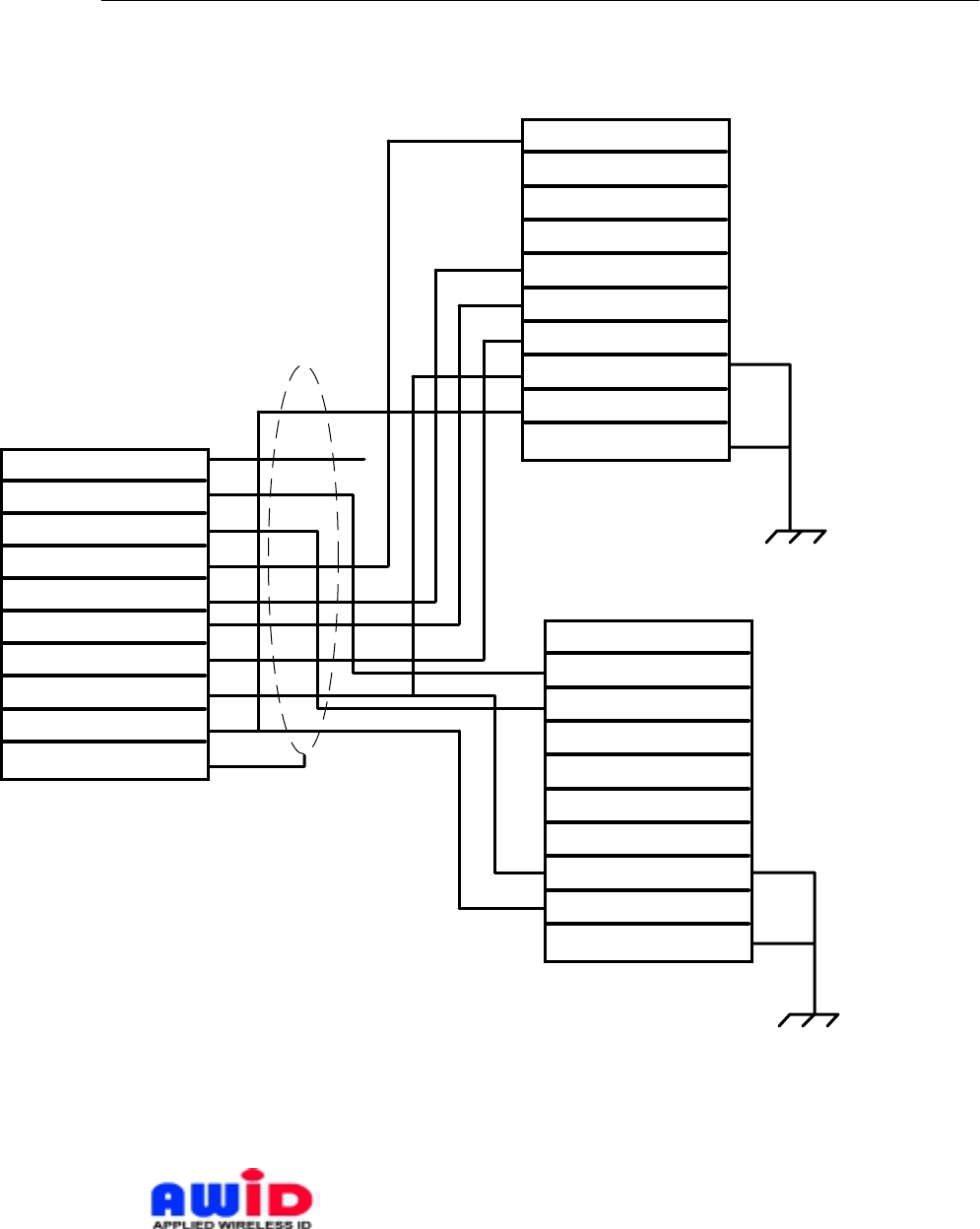
10
AWID PROPRIETARY
Ext Data (Yellow)
Data1 (White)
Data0 (Green)
RS Ground (Blue)
Reset (Brown)
Transmit (Violet)
Receive (Orange)
Ground (Black)
6-16 VDC (Red)
Shield Drain)
RS Ground
DSR
DTR
CTS
RTS
RXD
TXD
Ground
Power
Chassis Ground
Fig 5.2.3 Wiring Diagram For RS-232 & Wiegand Output Format
READER
RS-232 PANEL
Data1
Datao
Ground
Power
Chassis Ground
Wiegand PANEL
Earth
Ground
Earth
Ground
Braid

11
5.4 Mounting
a. Check to ensure all connections are secure. Feed all wires through the cable access
hole to the rear or the side of the mounting position.
b. Mount the Reader with the four #6-32 x 1” Machine screws, P/N: 0616MPP and the four
#6-32 Hex Machine Screw Nuts, P/N: 06NH (Item c and d on Parts List).
c. Insert the Screw hole plugs (Item d on Parts List) into the screw clearance holes to
conceal the screws. Note: screw hole plugs are designed for one-time use only!
Once the plugs are seated, they cannot be removed without damaging the plugs.
AWID PROPRIETARY
5.5 FCC RF Exposure compliance
Caution: to meet FCC RF Exposure compliance, operator(s) should
not be closer than 10.27 inches to a transmitting antenna.
Antennas must be labeled indicating minimum separation
distance per FCC RF Exposure requirements . If the
information on the label is not clearly visible, a sign with the same
information must be posted within 36 inches of the antenna.
Radio Frequency (RF) exposure
In order for this device to comply with FCC-adopted RF exposure limits, precautions must be
taken. To meet the requirements of the FCC’s Maximum Permissible Exposure (MPE)
guidelines, persons should not be closer than 10.27 inches (26.1 cm) to a transmitting antenna.
For installations where an operator must handle a tag or diagnostic tool closer than 9.88 inches
to the transmitting antenna, the operator should ensure that the RF antenna is not transmitting
prior to positioning the tag or tool. Once the operator has positioned the tag or diagnostic tool,
and moved away a minimum of 10.27 inches from the antenna, the antenna can be re-activated.
For all installations labels must be placed on individual antennas, or signs must be displayed,
indicating “CAUTION: A minimum separation distance of 10.27 inches must be maintained
between an antenna and persons for meeting FCC RF Exposure compliance. See Users
manual for details on operation requirements.” For more information on RF Exposure, where
incidental exposure may exceed the above guideline, please refer to the FCC Office of
Engineering and Technology Bulletin 65, Supplement C, Guidelines for Human Exposure to
Radio Frequency Electromagnetic Fields, available online at:
http://www.fcc.gov/oet/info/documents/bulletins/
AWID PROPRIETARY
6.0 WARRANTY

12
AWID’s products are warranted to the original purchaser to be free of defects in material and
workmanship for the life of the product. Any tampering or modification to the product will void
this product warranty. AWID does not warrant any product as to its merchantability or suitability
of use. AWID's sole and complete responsibility under this warranty is expressly limited to
repair or replacement of the warranted product.
7.0 RETURN MATERIAL AUTHORIZATION (RMA)
AWID monitors and tracks the life cycle performance of our product through our RMA system.
All customers must obtain a RMA number from AWID Customer Service Department prior to
returning the merchandise. After the customer provides AWID Customer Service Department
with the serial number and a description of the returning item, a RMA number will be issued.
This RMA number must be clearly marked on the outside of the returned package and
noted on the paperwork attached to the returned merchandise.
When obtaining a RMA number for RFID tags, please provide AWID’s Customer Service
Department with the serial numbers, card identification numbers, facility codes, etc. If exact
duplicates of returned cards or tags are requested, the customer must provide AWID with the
numbers needed. AWID reserves the option to replace or repair returned merchandise. Items
returned to AWID without the proper authorization will be returned to the originators at their own
expense.
8.0 TROUBLESHOOTING
This unit, if not installed in strict compliance with AWID’s installation instructions, may not
function to specifications. Use the checklist below to identify the problem:
• Is the tag valid and working? - Try a different tag
• Is the reader wired correctly? - Check All Wiring and Connections
• Is the unit grounded properly? - DRAIN-EARTH: less than 50 Ohms
• Is the card presented correctly? - Card face parallel to reader face
• Is a power supply correct? - Check voltage at power supply
• Is reader voltage/current correct? - 6V/1.2A…16V/0.4 A typical
• Is the environment free from electromagnetic interference? - Run cable away from other
data carrying cables and the reader away from electromagnetic interference sources!
AWID PROPRIETARY
13
When troubleshooting, try to identify the source of the problem to a unit level. “Is the problem
originating from the panel?” Or “is the problem originating from the Reader? “ Maybe the
problem “is the power supply?”
All AWID’s readers will need only a power supply and a valid card to work properly. If the
reader is connected with RED (+6…16V) and BLACK (Ground), and presented with a valid card,
the reader will successfully display valid data at the test computer.
To check the validity of the output data in the absence of a panel, you will need to build a patch
cable between the reader and a PC. Call AWID’s Technical Support for details.
If a problem persists, consult the system manufacturer. If problem is the reader, consult AWID’s
Technical Assistance Department. AWID help desk is opened from 8:00 AM to 8:00 PM
Eastern Standard Time, and can be reached by dialing 1-800-369-5533.
9.0 PATENTS AND APPROVALS
AWID products are covered by United States patent _________, patent pending.
AWID logo is a registered trademark of Applied Wireless Identifications Group, Inc.
Where required, AWID’s products are approved by the appropriate regulatory agencies:
U. S. Federal Communications Commission: Part 15
Underwriter Laboratory: Designed to meet UL 294
Designed to Comply with: CE, UL, VDE, BZT, DTI & PTT
Information To The User
This device complies with part 15 of the FCC Rules. Operation is subject to the following two
conditions: (1) this device may not cause harmful interference, and (2) this device must accept
any interference received, including interference that may cause undesired operation.